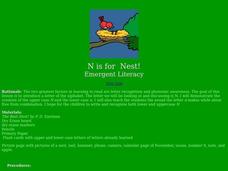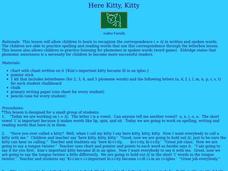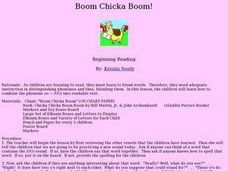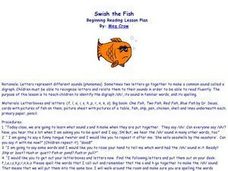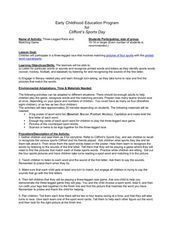Curated OER
The Fish Say Shhh
First graders identify the digraph /sh/ in written and spoken language. Students practice the production of the /sh/ sound through tongue twisters and riddles. They identify the initial and final placement of the new digraph /sh/ using a...
Curated OER
Champions of /Ch/
Young scholars identify the digraph /ch/ in written and spoken language. Students practice identifying initial and final placement of the digraph /ch/ in words by identifying pictures containing the sound. They decode and spell words in...
Curated OER
N is for Nest
Students identify the letter and phoneme /n/ in written and spoken language. Students practice the production of the /n/ sound through listening and matching activities. They identify the initial placement of the letter and sound using a...
Curated OER
Shhh Here and There
Students identify words containing the sh digraph in this lesson. They say a tongue twister which contains words emphasizing the sh digraph. They then read with a partner "One Fish, Two Fish, Red Fish, Blue Fish" and identify words in...
Curated OER
Perfectly Popping
Students identify p in spoken words and the written letter the represents it. The story, Hop on Pop by Dr. Seuss is read the the class. They then have to circle pictures that have the p sound in them. This assessment is done after...
Curated OER
Gorilla Girl Grows Green with the Letter G
Learners practice recognizing the letter g in spoken words. They identify the phoneme g=/g/ by listening and saying it in words. Students read Planting a Rainbow and identify words with the letter g. They create green, glittered G's on...
Curated OER
Mr. Cloak Loads his Boat with Oats
First graders distinguish between the sounds for short vowel o and long vowel o. They are introduced to the vowel patterns that comprise long vowel sounds, with a particular emphasis on /oa/. They practice reading and identifying a...
Curated OER
Here Kitty, Kitty
Learners recognize the short vowel i in written and spoken language. Through matching activities, they discriminate the short vowel /i/ from other vowel sounds. Students associate the phoneme with its letter representation and identify...
Curated OER
Boom Chicka Boom
Students recognize how vowel patterns change a short vowel sound into a long vowel sound. With an emphasis on the /oo/ that makes the long U sound, students identify the phoneme and letter combination through listening and matching...
Curated OER
Hello H!
Students recognize the letter h in print and the phoneme /h/ in spoken words. They say a tongue twister with contains words emphasizing the /h/ sound. They then listen to the story "Horton Hears a Who" and identify the words with the...
Curated OER
Hop on Pop - Short 'o'
Students practice the alphabetic significance of the letter /o/ along with its awareness of phonemes in spoken words. They assess on construction paper the phrase, "We like to hop on top of Pop who's on top of a hot rock" written on it...
Curated OER
Sneeze Cheese
Students study the /ch/ digraph by thinking of the sound that is made when someone sneezes. They listen to a tongue twister while identifying how many times they hear the /ch/ sounds and make words using the Elkonin boxes and letters....
Curated OER
Swish the Fish
Pupils study the /sh/ phoneme by making the sound, and reciting a tongue twister. Next, they make words that the teacher models using their Elkonin letterboxes. While using the big book version of Dr. Seuss', One Fish, Two Fish, Red...
Curated OER
Marvelous Muffins!
Students study the letter "m" in written and spoken words by making the sound, reciting a tongue twister, and writing the letter. They identify the sound in words and in Laura Joffe Numeroff's book, "If You Give a Moose a Muffin". Next,...
Curated OER
Clifford's Sports Day
First graders participate in a game of three legged race that involved the practice of matching pictures or text. They use the subject of sports to create the context. Students play the game to strengthen classification and reading...
Curated OER
Ewww, That's Gross
Students recognize the /ew/ digraph in written and spoken words by reading and spelling words with ew=/oo/. They say a tongue twister emphasizing words with the /ew/ digraph. They then listen to the story "Shoe Man" and identify the...
Curated OER
Isabelle the Icky Iguana
Learners practice the sound and spelling of the short vowel /i/. They identify the short /i/ sound in spoken and written words. The tongue twister "Isabelle iguana is in her igloo," and "Tin Man Fix It," along with Elkonin letter boxes...
Curated OER
Rhyme Rally
Students are introduced to rhyming words and practice identifying them in a story or poem. In this rhyming words lesson, students listen to a story while paying listening for rhyming words in the story. Students then replace rhyming...
Curated OER
Icky Fingers
Which i sound is used in the word icky? Kindergarteners and first graders listen to the short /i/ sound. They practice shaking their fingers to indicate icky when they hear the target sound. Then they practice reading a poster with the...
Curated OER
The Creaky Door Says "ehhhh"
Study the long vowel sound /e/, as in a creaky door noise. Children repeat the sound and learn a chant. They use letters in letterboxes to make words with the /e/ sound before reading a book and writing a message about their favorite...
Curated OER
Achoo!
Focus in on the digraph ch. Young readers will hear the sound, print the letters, and read A Peach for Chad. Can your youngsters think of any more words that use the target sound?
Curated OER
Peachy Teacup by the Stream
Help your kids distinguish between the sounds for short vowel /e/ and long vowel /e/. They are introduced to the vowel patterns that comprise long vowel sounds, with a particular emphasis on /ea/. They practice reading and spelling a...
Curated OER
Cheese Please
Do you like cheese? What sound does the word start with? Learn all about the /ch/ sound and what other words make the same sound.
Curated OER
Final Consonant Sounds: Review - ft, ld, lt, mp, nd
These are challenging phonics review sheets. On the first page, learners match the end sounds to the pictures and write a rhyming word for each word. For the second page, pupils choose an end sound to complete a series of incomplete...


